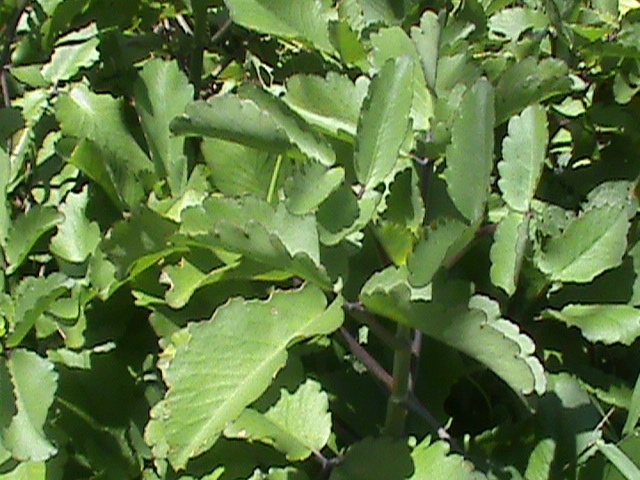Cathedral Bells
(Kalanchoe pinnata)
Cathedral Bells (Kalanchoe pinnata)
/
/

Alejandro Alfredo Aguirre
CC BY 4.0
Image By:
Alejandro Alfredo Aguirre
Recorded By:
Copyright:
CC BY 4.0
Copyright Notice:
Photo by: Alejandro Alfredo Aguirre | License Type: CC BY 4.0 | License URL: http://creativecommons.org/licenses/by/4.0/ | Rights Holder: Alejandro Alfredo Aguirre | Publisher: iNaturalist | Date Created: 2020-10-24T10:13:09-07:00 |

























Estimated Native Range
Summary
Kalanchoe pinnata, commonly known as cathedral bells, air plant, life plant, miracle leaf, Goethe plant, and love bush, is a succulent perennial herb native to Madagascar and found in tropical and subtropical climates worldwide. It thrives in rocky and sandy soils, often in areas that are seasonally dry. This species is known for its ability to propagate through plantlets that form on the margins of its leaves, a trait that contributes to its invasive potential in suitable climates. Kalanchoe pinnata typically grows to about 3 feet tall with erect, fleshy cylindrical stems. The leaves are thick, fleshy, elliptical, and can have a reddish tinge. It blooms with clusters of red-orange, bell-shaped flowers in a terminal inflorescence, which are particularly showy and attract pollinators.
Cathedral bells are valued for their medicinal properties and are used in traditional medicine to treat a variety of ailments. They are also popular as ornamental plants due to their unique foliage and attractive flowers. In cultivation, they require minimal care, thriving in well-drained soil and tolerating periods of drought. They perform best in full sun to partial shade. When grown outdoors in non-native regions, care should be taken to prevent their spread, as they can become invasive. In regions where they are not invasive, they can be used in rock gardens, as border plants, or in containers.CC BY-SA 4.0
Cathedral bells are valued for their medicinal properties and are used in traditional medicine to treat a variety of ailments. They are also popular as ornamental plants due to their unique foliage and attractive flowers. In cultivation, they require minimal care, thriving in well-drained soil and tolerating periods of drought. They perform best in full sun to partial shade. When grown outdoors in non-native regions, care should be taken to prevent their spread, as they can become invasive. In regions where they are not invasive, they can be used in rock gardens, as border plants, or in containers.CC BY-SA 4.0
Plant Description
- Plant Type: Succulent
- Height: 2-5 feet
- Width: 2-4 feet
- Growth Rate: Moderate
- Flower Color: Cream, Green
- Flowering Season: Spring, Summer
- Leaf Retention: Evergreen
Growth Requirements
- Sun: Full Sun, Part Shade
- Water: Low, Medium
- Drainage: Medium
Common Uses
Edible*Disclaimer: Easyscape's listed plant edibility is for informational use. Always verify the safety and proper identification of any plant before consumption., Low Maintenance, Potted Plant, Showy Flowers, Street Planting
Natural Habitat
Native to rocky and sandy soils in seasonally dry areas of Madagascar
Other Names
Common Names: Life Plant, Cathedral Bells, Miracle Leaf
Scientific Names: , Kalanchoe pinnata, Baumgartenia sobolifera, Bryophyllum calcicola, Bryophyllum calycinum, Bryophyllum germinans, Bryophyllum pinnatum, Bryophyllum pinnatum, Bryophyllum pinnatum, Bryophyllum pinnatum subsp. simplicifolium
GBIF Accepted Name: